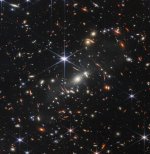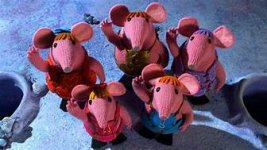You are using an out of date browser. It may not display this or other websites correctly.
You should upgrade or use an alternative browser.
You should upgrade or use an alternative browser.
[Technology] *** James Webb Space Telescope ***
- Thread starter Hugo Rune
- Start date
More options
Who Replied?Horton's halftime iceberg
Blooming Marvellous
Nice space tracker of where (in the middle of lots of nowhere) it is
https://www.jwst.nasa.gov/content/webbLaunch/whereIsWebb.html
https://www.jwst.nasa.gov/content/webbLaunch/whereIsWebb.html
Tom Hark Preston Park
Will Post For Cash
- Jul 6, 2003
- 71,958
Astounding stuff. Represents mankind's greatest chance of expanding its limits of knowledge and locating Ulloa penalty
- Thread starter
- #24
“All four science instruments on NASA's James Webb Space Telescope have achieved "perfect alignment" in advance of the telescope's official debut this summer, project officials said in a news teleconference on Monday (May 9).”
NASA have released a comparison image of stars in another galaxy. You can get a real idea of the upgrade from retired Spitzer space telescope.

NASA have released a comparison image of stars in another galaxy. You can get a real idea of the upgrade from retired Spitzer space telescope.

Dick Swiveller
Well-known member
- Sep 9, 2011
- 9,440
The Danny Webb telescope, however, spent a couple of months going round in circles without finding its target and has since been transferred from small country space agency to small country space agency.
Johnny RoastBeef
These aren't the players you're looking for.
- Jan 11, 2016
- 3,460
First full colour science grade image to be unveiled tonight at 9pm.
First full colour science grade image to be unveiled tonight at 9pm.
Of what...
... Uranus?
- Thread starter
- #28
Of what...
... Uranus?
Let’s get to the bottom of this:
“What will the first Webb images show?
Yesterday NASA confirmed these five objects will feature in Webb’s first images:
Carina Nebula: one of the largest and brightest nebulae in the sky, located approximately 7,600 light-years away in the southern constellation Carina.
WASP-96b (spectrum): a giant planet outside our solar system, composed mainly of gas. The planet, located nearly 1,150 light-years from Earth, orbits its star every 3.4 days. It has about half the mass of Jupiter, and its discovery was announced in 2014.
Southern Ring Nebula: The Southern Ring planetary nebula – an expanding cloud of gas surrounding a dying star - is 2,000 light-years away from Earth.
Stephan’s Quintet: About 290 million light-years away, Stephan’s Quintet is a group of galaxies located in the constellation Pegasus.
SMACS 0723: an extremely distant and intrinsically faint cluster of ancient galaxies imaged using gravitational lensing.”
- Thread starter
- #29
First full colour science grade image to be unveiled tonight at 9pm.
They’ve still not unveiled anything. NASA were going to brief Biden and Harris, perhaps they’ve seen something they shouldn’t have?

Winker
CUM ON FEEL THE NOIZE

“This slice of the vast universe covers a patch of sky approximately the size of a grain of sand held at arm’s length by someone on the ground”
4.6Bn LY away.
Just astounding.
https://www.nasa.gov/image-feature/...livers-deepest-infrared-image-of-universe-yet
Knocky's Nose
Mon nez est retiré.
Your clangers, right next to Uranus...

*unless you're over 50, then they're technically nearer to your knees...
Tom Hark Preston Park
Will Post For Cash
- Jul 6, 2003
- 71,958
Further images being unveiled today. This from the BBC:
'Nasa is holding a webcast on Tuesday to showcase further imagery from the new telescope. There are many places where you can view this presentation, including on the European Space Agency's web TV channel. Programming starts at 14:45 BST, 15:45 CEST; 09:45 EDT. Other viewing possibilities include the Canadian Space Agency's YouTube channel; and on Nasa Live. BBC Two television will air a special programme on Webb - Super Telescope: Mission to the Edge of the Universe - on Thursday at 20:00 BST.'
'Nasa is holding a webcast on Tuesday to showcase further imagery from the new telescope. There are many places where you can view this presentation, including on the European Space Agency's web TV channel. Programming starts at 14:45 BST, 15:45 CEST; 09:45 EDT. Other viewing possibilities include the Canadian Space Agency's YouTube channel; and on Nasa Live. BBC Two television will air a special programme on Webb - Super Telescope: Mission to the Edge of the Universe - on Thursday at 20:00 BST.'
- Thread starter
- #35
This is the game changer for me:
WASP-96b (spectrum): a giant planet outside our solar system, composed mainly of gas. The planet, located nearly 1,150 light-years from Earth, orbits its star every 3.4 days. It has about half the mass of Jupiter, and its discovery was announced in 2014.
The spectrometer could be able to decipher the atmosphere of this planet. If successful, we could identify other planets with an atmospheric composition that would suggest life.
WASP-96b (spectrum): a giant planet outside our solar system, composed mainly of gas. The planet, located nearly 1,150 light-years from Earth, orbits its star every 3.4 days. It has about half the mass of Jupiter, and its discovery was announced in 2014.
The spectrometer could be able to decipher the atmosphere of this planet. If successful, we could identify other planets with an atmospheric composition that would suggest life.
View attachment 149598
“This slice of the vast universe covers a patch of sky approximately the size of a grain of sand held at arm’s length by someone on the ground”
4.6Bn LY away.
Just astounding.
https://www.nasa.gov/image-feature/...livers-deepest-infrared-image-of-universe-yet
Is it just me that thinks that the processing of this image had gone beyond what’s needed and dived into Walt Disney world. I’m sorry (and I know nothing) but I just don’t believe the “twinkle twinkle little star” thingy in the middle. Either the camera’s got some grease on it or someone’s got carried away with photoshop.
Tom Hark Preston Park
Will Post For Cash
- Jul 6, 2003
- 71,958
Age of the universe is pretty much established as approximately 13.8 billion years old. James Webb telescope is reported as being able to see 13 billion years into the past. Wonder what James Webb 2.0 would see if it could see, say, 14 or 15 billion years into the past? Ulloa penalty maybe?
Is it just me that thinks that the processing of this image had gone beyond what’s needed and dived into Walt Disney world. I’m sorry (and I know nothing) but I just don’t believe the “twinkle twinkle little star” thingy in the middle. Either the camera’s got some grease on it or someone’s got carried away with photoshop.
They are called diffraction spikes. Everything in that photo that has one is a star (effectively a point source). Everything else...is a galaxy...
https://en.wikipedia.org/wiki/Diffraction_spike
Is it just me that thinks that the processing of this image had gone beyond what’s needed and dived into Walt Disney world. I’m sorry (and I know nothing) but I just don’t believe the “twinkle twinkle little star” thingy in the middle. Either the camera’s got some grease on it or someone’s got carried away with photoshop.

Being serious for a sec: The ‘twinkle twinkle little star’ thingy is in fact, errr, a star. Only, much nearer than the lensing galaxy cluster (4.6Bn LY) in the centre, and the red smears which are the much more distant (c13Bn LY) galaxies that have been focused and magnified by the lensing cluster.
Bold Seagull
strong and stable with me, or...
Fascinating stuff. I hadn't realised it was a) so far away and b) orbiting the sun in an L2 orbit.

